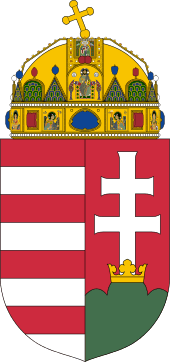Hungarian parliamentary election, 1939
 |
| This article is part of a series on the politics and government of Hungary |
| Foreign relations |
Parliamentary elections were held in Hungary on 28 and 29 May 1939.[1] The result was a victory for the Party of Hungarian Life, which won 181 of the 260 seats in Parliament. Pál Teleki remained Prime Minister.[2]
Electoral system
The electoral system was changed from that used in 1935. The number of single-member constituencies was reduced from 199 to 135, whilst the number of multi-member constituencies was raised from 11 to 38.[3][4]
Results
| Party | SMCs | MMCs | Total | |||||||
|---|---|---|---|---|---|---|---|---|---|---|
| Votes[a] | % | Seats | Votes[b] | % | Seats | Votes | % | Seats | +/– | |
| Party of Hungarian Life | 766,694 | 51.3 | 112 | 1,057,879 | 48.2 | 69 | 1,824,573 | 49.5 | 181 | +17 |
| Independent Smallholders Party | 228,571 | 15.3 | 1 | 340,483 | 15.5 | 13 | 569,054 | 15.4 | 14 | –8 |
| Arrow Cross Party | 192,356 | 12.9 | 7 | 338,049 | 15.4 | 22 | 530,405 | 14.4 | 29 | New |
| Social Democratic Party | 12,630 | 0.8 | 0 | 113,607 | 5.2 | 5 | 126,637 | 3.4 | 5 | –6 |
| United Hungarian National Socialist Party | 54,887 | 3.7 | 3 | 23,919 | 1.1 | 1 | 78,806 | 2.1 | 4 | New |
| National Front | 28,341 | 1.9 | 2 | 36,014 | 1.6 | 1 | 64,355 | 1.7 | 3 | New |
| Civic Freedom Party | 873 | 0.1 | 0 | 57,766 | 2.6 | 5 | 58,639 | 1.6 | 5 | – |
| Christian National Socialist Front | 40,114 | 2.7 | 1 | 47,419 | 2.2 | 2 | 57,533 | 2.4 | 3 | New |
| United Christian Party | 19,970 | 1.3 | 3 | 36,973 | 1.7 | 1 | 56,943 | 1.5 | 4 | –11 |
| Unofficial Party of Hungarian Life candidates | 46,802 | 3.1 | 0 | – | – | – | 46,802 | 1.3 | 0 | –6 |
| Hungarian National Socialist Agricultural Labourers' and Workers' Party | 13,010 | 0.9 | 1 | 23,127 | 1.1 | 2 | 36,137 | 1.0 | 3 | New |
| National Reform Party | 4,489 | 0.3 | 0 | 17,633 | 0.8 | 0 | 22,122 | 0.6 | 0 | New |
| Christian National Independence Party | – | – | – | 14,024 | 0.6 | 0 | 14,024 | 0.4 | 0 | New |
| Hungarian National Socialist Party | 10,872 | 0.7 | 0 | – | – | – | 10,872 | 0.3 | 0 | –2 |
| People's Will Party | 8,970 | 0.1 | 1 | – | – | – | 8,970 | 0.2 | 1 | 0 |
| National Smallholders, Craftsmen and Workers Party | 6,110 | 0.4 | 0 | – | – | – | 6,110 | 0.2 | 0 | New |
| Independent People's Party | – | – | – | 3,568 | 0.2 | 0 | 3,568 | 0.1 | 0 | New |
| National Agricultural Labourers, Craftsmen and Workers Party | 3,453 | 0.2 | 0 | – | – | – | 3,453 | 0.1 | 0 | New |
| Christian Opposition | – | – | – | 2,384 | 0.1 | 0 | 2,384 | 0.1 | 0 | –1 |
| Hungarian Racist Party | 1,288 | 0.2 | – | – | – | 1,288 | 0.0 | 0 | New | |
| Independents | 22,898 | 1.5 | 4 | – | – | 4 | 22,898 | 6.2 | 8 | –2 |
| Invalid/blank votes | 70,581 | – | – | 150,938 | – | – | 221,519 | – | – | – |
| Total | 1,546,130 | 100 | 135 | 2,343,992 | 100 | 125 | 3,908,122 | 100 | 260 | +15 |
| Registered voters/turnout | 1,719,221 | 91.0 | – | 2,636,557 | 88.9 | – | 4,355,778[c] | 89.7 | – | – |
| Source: Nohlen & Stöver | ||||||||||
a The number of votes refers to only 125 of the 135 single-member constituencies, as 10 seats were uncontested.[3]
b The number of votes refers to 36 of the 38 MMCs as two were uncontested.[3]
c The total number of registered voters was 4,629,493; the figure in the table refers to the number of registered voters in the contested seats.[3]